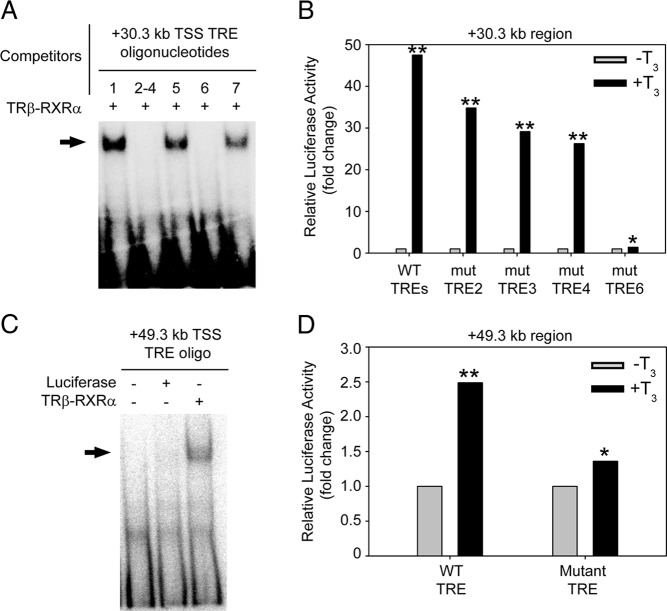Figure 3.
Predicted TREs at the mouse Dnmt3a locus bind TR-RXR heterodimers in vitro and support T3-dependent transactivation. A, We conducted competitive electrophoretic mobility shift assay (EMSA) using a [32P]-labeled oligonucleotide probe corresponding to a X. tropicalis dnmt3a TRE (Y. Kyono and R. J. Denver, unpublished data), and radioinert duplex oligonucleotides with sequences of 7 putative TREs found within the region centered at +30.3 kb from the TSS of the mouse Dnmt3a gene (see Supplemental Figure 2 for the locations of the predicted TREs; positions 2, 3, and 4 overlap, so we synthesized a single oligonucleotide that encompasses these 3 predicted TREs; oligonucleotide sequences are given in Supplemental Figure 2). Before gel electrophoresis we incubated the probe with in vitro synthesized Xenopus TRβ plus RXRα with or without radioinert duplex oligonucleotides (1μM). The arrow indicates the location of shifted bands due to TRβ-RXRα binding to the probe. Radioinert oligonucleotides corresponding to TREs 2–4 and 6 completely displaced TRβ-RXRα binding to the probe, whereas those for TREs 1, 5, and 7 had no activity. B, We tested for transcriptional activity of a 500-bp DNA fragment centered at +30.3 kb from the mouse Dnmt3a TSS in transient transfection-reporter assays using Neuro2a[TRβ1] cells. After transfection, we treated cells with vehicle (0.1% DMSO) or T3 (30nM) for 5 hours before conducting dual luciferase assay. This fragment supported T3-dependent transactivation, which was reduced by mutations introduced into TREs 2, 3, and 4, and was almost completely abolished by mutation of TRE 6 (P = .02). Bars represent the mean fold change in firefly luciferase activity (normalized to Renilla luciferase activity) relative to vehicle-treated controls (n = 3/treatment). C, We conducted EMSA using a [32P]-labeled oligonucleotide probe corresponding to the mouse +49.3-kb TRE sequence (Supplemental Table 2) and in vitro synthesized TRβ plus RXRα. In vitro synthesized luciferase was used as a negative control. The arrow indicates the location of the shifted band due to TRβ-RXRα binding to the probe. D, We tested for transcriptional activity of a 500-bp DNA fragment centered at +49.3 kb from the mouse Dnmt3a TSS in transient transfection-reporter assays using Neuro2a[TRβ1] cells. After transfection, we treated cells with vehicle (0.1% DMSO) or T3 (30nM) for 5 hours before conducting dual luciferase assay. This fragment supported T3-dependent transactivation, which was reduced by mutation of the single predicted TRE located in this region. Bars represent the mean fold change in firefly luciferase activity (normalized to Renilla luciferase activity) relative to vehicle-treated controls (n = 4/treatment). Asterisks indicate statistically significant differences between treatments (*, P < .01; **, P < .001; Student's independent sample t test).

